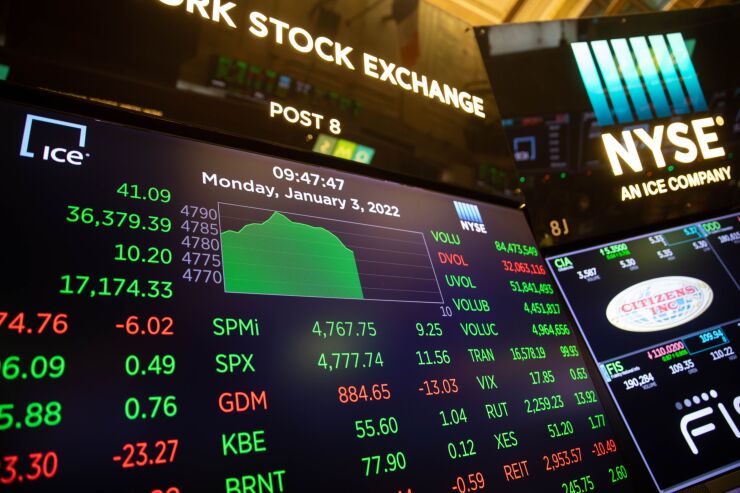A joint drop in equities and bonds is hitting exchange-traded fund investors with the worst start of a year in a decade.
Investors who subscribe to the moderate-risk portfolio strategy of 60% stocks and 40% bonds have been walloped this week. Treasury yields spiked higher on concerns the Fed will
The specter of interest rate hikes also fueled a rout in highly valued tech stocks, whose future earnings become less valuable when rates increase.

The iShares 20+ Year Treasury Bond ETF (TLT) fell in each of the first three sessions, driving its 2022 losses to 3.6%. Meanwhile, the SPDR S&P 500 ETF Trust (SPY) erased its year-to-date gains Wednesday. Combined, their 2022 losses reached almost 5%, marking the worst start to a year since TLT was created in July 2002.
This is what happens “when the bartender responsible for providing all that liquidity turns to a doctor dispensing tough medicine,” said Max Gokhman, chief investment officer at AlphaTrAI. “It’ll be harder to make broad sector and asset-class bets in this kind of market.”
The dire performances are bad news for the popular 60/40 stock-bond portfolio strategy. But they are a vindication to those who
During the last two decades, subdued growth boosted the allure of the strategy, one that’s built on a negative stock/bond correlation, where one served as buffer for the other. Now, with the Fed poised to hike interest rates to combat raging inflation, the bond-stock relationship could be upended.
At stake are trillions of dollars that are managed at risk parity funds, balanced mutual funds, and pension funds that follow the framework of 60/40 asset allocation. The RPAR Risk Parity ETF (RPAR), for instance, dropped 2.7% over three days for the worst stretch since the pandemic bottom in March 2020.
Diversification fans note that the
Inflation and higher wages can push earners up a tax bracket, while unchanged deductions can spark bigger tax bills.
A Bloomberg model tracking a portfolio of 60% stocks and 40% fixed-income securities has climbed all but one year since the 2008 global financial crisis. It was down 0.1% this year before Wednesday.
In the eyes of bulls, rate hikes are an acknowledgment of a strengthening economy that’s the backbone of corporate profits. While this year’s sudden spike in Treasury yields may have forced some unwinding in some speculative corners of the equity market, Wall Street strategists expect the S&P 500 to continue marching higher this year, driven by robust earnings.
“There are few places to seek cover on days like these but fortunately, we expect bond yields to drift higher but at a more gradual pace,” said Adam Phillips, managing director of portfolio strategy at EP Wealth Advisors. “Higher yields will naturally pose a challenge to longer-duration equities like technology stocks, so sector positioning will be important going forward.”






